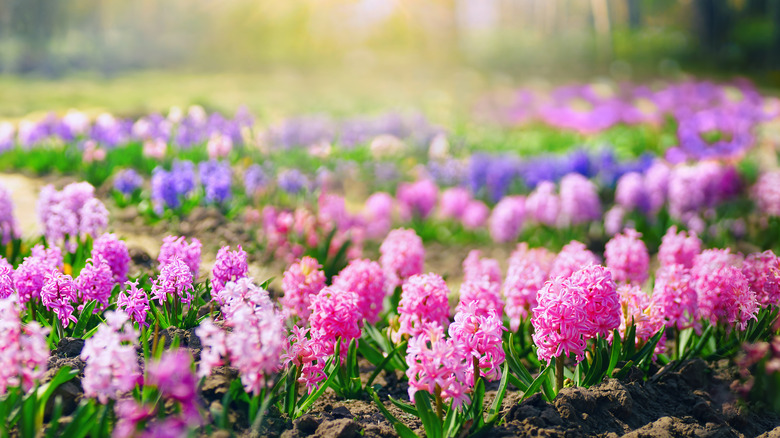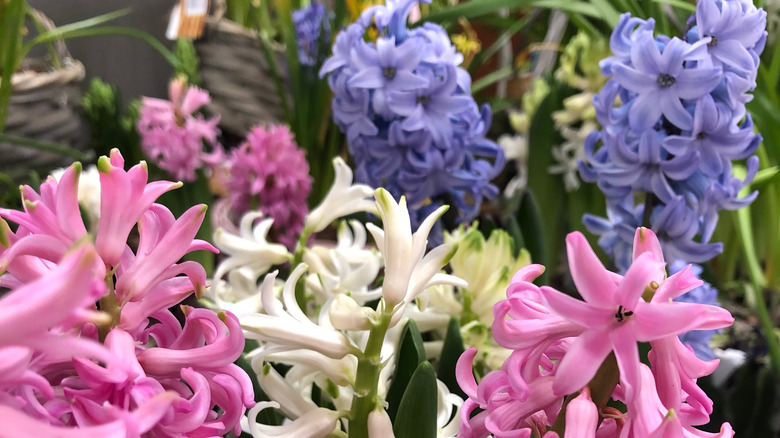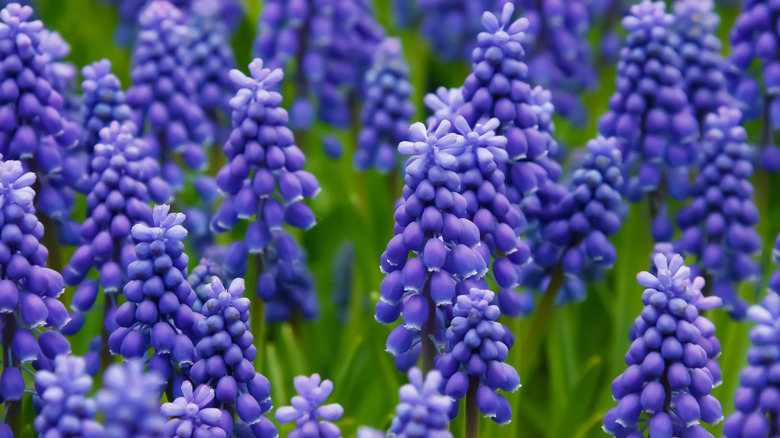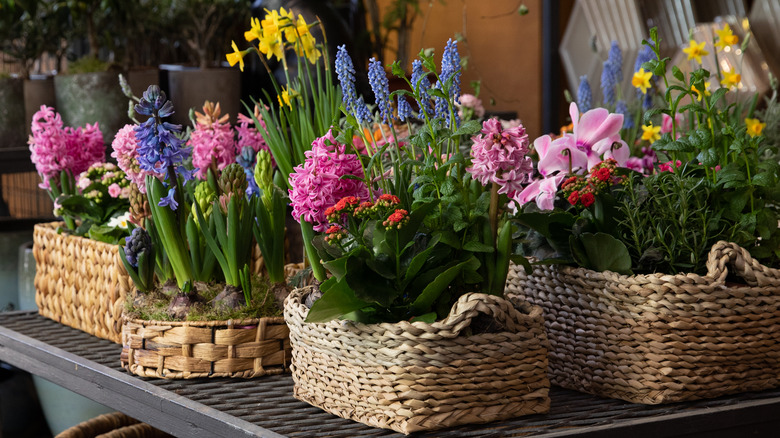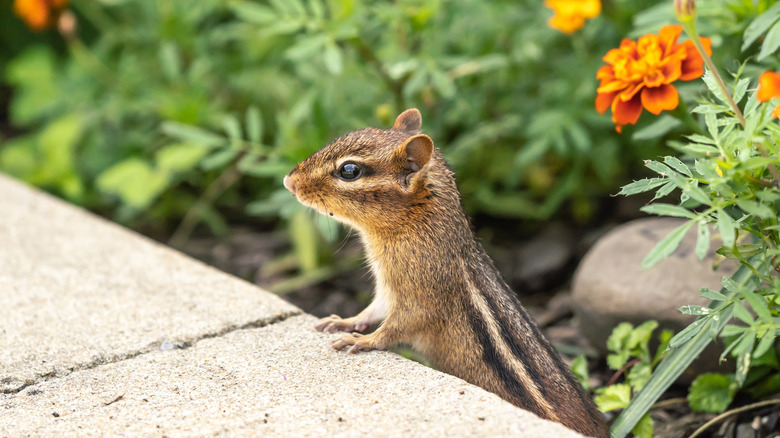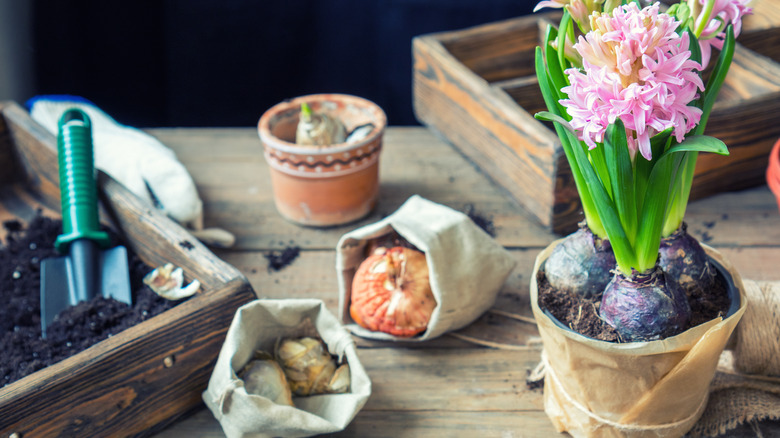Mistakes Everyone Makes When Planting Hyacinths
The flowers of the hyacinth look so pretty in a garden, with their waxy star-shaped florets and the blooms' bursts of mostly bright pastel colors, including lilac, pink, lavender, apricot — or if you're looking for something more dramatic, there is the blood-red version. These perennials visit early each spring, one of the first to bloom, and their fragrance is so lovely that some say it's "nature's perfume," according to The Old Farmer's Almanac.
Additionally, hyacinths allow versatility — you can put them in a bed, grow them in a pot, gather a bunch for a lovely vase arrangement, use them for a window box, plant them in groups, or isolate a few here and there around your garden, suggested Plant Care Today. There's a ton of varieties, too, from water hyacinths to grape hyacinths to Dutch hyacinths.
Hyacinths come from bulbs, which contain fuel for the plant so it continues to thrive until it can bloom again next spring, according to Reviewed. Bulbs come in different varieties such as tubers, corms, and rhizomes, but generally just go by their generic name. In general, hyacinths are super easy to grow and maintain, but there are a few things you should know about these flowers.
Plant hyacinths at the right time and temperature
Hyacinths like the cold, at least during the beginning of their flowery lives. This means that temperatures should reach 40 to 45 degrees fahrenheit for about 12 to 14 weeks to make the bulbs develop correctly. So keep in mind that if you reside in a warmer region, hyacinth bulbs will need pre-chilling in the refrigerator before being planted. Additionally, since the bulbs like lower temperatures, plant hyacinth bulbs sometime mid- to late-autumn after the first fall frost has come and gone, but before the ground is frozen and you cannot dig into the dirt (via The Old Farmer's Almanac).
Hyacinth bulbs can also be grown indoors using a process similar to the method you use outside in your garden. This version you'll also plant in the early fall and ensure there's a proper cooling process, allowing the bulbs to remain in 40 to 45 degree fahrenheit temperatures for the same 12 to 14 weeks, or longer. When spring finally arrives, all you need to do is move the pots into a bright, warm room and the blossoms will come out, as noted by Long-field Gardens.
Find nurturing conditions for hyacinths
To allow hyacinths to reach the apex of their growth, you want to choose a sunny place for planting. While partial shade works too, you'll get larger flowers and straighter stems when lots of sun shines down on your garden, according to Longfield Gardens.
Hyacinths are a bit picky when it comes to water; they like a well-drained environment. You don't want the flowers in spaces where water can gather since the hyacinths can get gray mold or bulb or root rot when they sit too long in sodden dirt. Resist using your sprinklers — hyacinths do better when the water comes at the soil level; for instance, you can use an on-the-ground hose or the soaker variety. Be sure to give the soil time to dry between waterings (via The Old Farmer's Almanac).
Use fertilizer carefully — hyacinths don't need much. In fact, some organic compost does the job nicely, in general. Otherwise, you might cause the leaves to grow rapidly, lessening the amount of blooms that will appear, and you don't want that. You can also encourage more flowering by deadheading the hyacinth after the florets wither away, per Do It Yourself.
Be precise when planting hyacinths
For the perfect results, put hyacinths into the ground at about six to eight inches deep, said Do It Yourself. This ensures that the roots will attach themselves firmly into the ground, allowing the stem the sturdiness needed to support all those florets. It also protects the bulb from pests like nematodes that gather on the soil's surface and try to kill your flowers.
Generally, you want to plant the bulbs four inches apart, according to Plant Care Today. If you are creating a grouped look and need to plant several bulbs in the same place, make sure to remove soil until you create a large area for planting. In a planter, you can usually put six to seven bulbs to an eight-inch container and then increase one to two more for each size above that (for instance, eight to nine bulbs in a 10-inch container). For a garden bed, try using five to nine bulbs to create a nice gathering that's not too bulky.
Don't forget to plant the bulb pointy side up, and cover it well with the soil, offered Better Homes & Gardens. Your final touches should include a sprinkling of water and adding one to two mulch layers around the plants to keep weeds to a minimum.
Be mindful and protect animals, yourself, and your hyacinths
Hyacinth bulbs contain oxalic acid (as do daffodil bulbs), an irritant to human and animal skin, so be sure to wear gloves when doing your planting (via The Old Farmer's Almanac). The substance can also make your stomach queasy and lead to respiratory issues. Sometimes people eat the bulbs, confusing them with onions because both are sometimes stored in kitchens, reported Science Direct. You don't want to do this because the bulb can poison you, causing nausea, vomiting, stomach cramps and an assortment of experiences that aren't fun.
Because of the toxic nature of hyacinth bulbs, squirrels and most other pesky fauna leave them alone — so at least you won't need to worry about keeping those animals away. Still, some persistent chipmunks, voles, etc. might attempt to dig up your hyacinth plants. Keep them away by making a tin can sleeve, suggested Gardener's Path. Take a can and open each end. You'll keep the hyacinth safe by planting them inside of it. Dig down at least four inches and adjust the can so the rim is slightly below the ground. The can will keep the critters away, but allow room for root growth so the flower stays healthy and beautiful.
After the flowers fade, you still need to care for hyacinths
When the hyacinths' blooms disappear, don't pluck away the remaining green foliage; next year's blossoms depend on the leaves to fuel the next crop. By the end of the season, the plant withers and you can remove the brown and yellowed leaves at that point, said Gardening Know How. The website recommends considering supplemental feeding twice a year — when the plant's stem first peeks through the soil and then again in early autumn. The fall is especially important since it bolsters the bulb to last through the winter. Use a dry garden fertilizer and then water. Only fertilize during these times since adding such an ingredient after blooming can facilitate rot formation.
Gardeners living in warm places may need to dig up bulbs if temperatures never get colder, according to HGTV. If that means you, find a cool, dry space to store them until it is autumn and time to re-plant. With a little planning and some care, your hyacinths will flourish, and every spring you can anticipate their bright colors decorating your garden.
